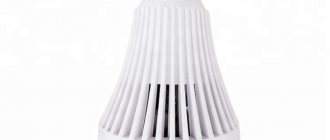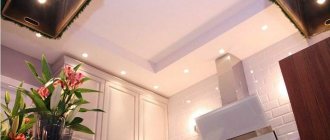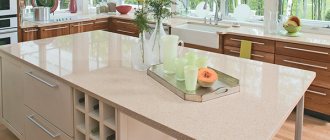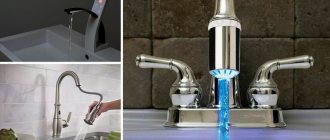The hood has long been considered an integral part of any modern kitchen. By purifying the air, absorbing foreign odors and combustion products, it rids the room of soot and smoke, thereby maintaining a comfortable and safe environment in it.
Leading manufacturers, including the German company Krona, offer a huge range of kitchen air purifiers in various form factors: island, suspended, inclined, T-shaped, built-in, country, with and without a dome. By the way, it was dome models that became the progenitors of all existing formats. Appearing back in the 50s of the last century, they remain one of the most popular to this day - of course, in an improved and technically updated form.
Dome near the hood
The main distinguishing feature of dome hoods is the volumetric canopy - a dome in which the motor, fans and filtration system are hidden. Visually, it resembles a rustic stove or fireplace, and therefore such models are often called “fireplace”.
The large dimensions of dome hoods are their disadvantage and advantage at the same time. On the one hand, it is not possible to install such a unit in every kitchen, because models from Krona can have a height of up to 128 cm and a width of up to 90 cm. On the other hand, this allows you to fit powerful motors and high-quality filters with a large capture area inside, making this the technique most effectively captures the smallest particles of soot and burning, regardless of how many burners are used on your hob.
Additional selection criteria
Noise level
The noise a hood makes during operation can be annoying and distracting. Moreover, the greater the performance of the device, the higher the noise level may be, which may depend on many factors: the diameter of the air duct, its length, the presence of bends, etc. That is why, while in a sales area, it is quite difficult to determine the real noise level by ear. When purchasing, it is better to focus on the noise indicators (measured in DB) specified in the instructions:
- 45 dB – these are the indicators for the quietest operating devices;
- 50 dB is the average noise level and the norm for most hoods;
- 55 dB – quite noisy, but at the same time powerful hoods;
- 60 dB or more is a very high noise level, harmful.
To achieve low noise levels, manufacturers equip hoods with special anti-vibration gaskets that separate the motor and housing, and sound-absorbing plates.
Lighting
Lighting is provided in hoods using various lamps. Budget models are usually equipped with one lamp, while more expensive ones have from three to five lamps. There are hoods with focusing lighting, scattering light, and some models have built-in sensors that respond to the approach of a person.
Additional features
Many hoods have a set of various useful functions, for example, such as:
- Residual stroke , which allows you to clean the room after completely turning off the hood.
- Interval mode , which ensures that the device turns on independently at the lowest power with an interval of 5-10 minutes, so that the air in the kitchen will be renewed regularly.
- An electronic timer turns off the hood after a certain period of time.
- Remote control is present in expensive models that are equipped with a remote control that allows you to control the hood from a distance. Some models have a remote control type, with which you can regulate the operation of the device from a smartphone or computer.
What kind of interior is a dome hood suitable for?
Krona dome hoods will delight you not only with their filling, but also with their variety of styles. The German brand's catalog features neutral black and white air purifiers that combine clean lines and minimalist design. Also here you will find spectacular devices with a case made of ultra-modern stainless steel - what you need for loft, hi-tech or modern style! Are you looking for a classic-style kitchen hood? Then we recommend that you pay attention to the line of dome kitchen air purifiers in the “country” style with a massive retro dome and a spectacular baguette made of natural wood. Regardless of the design, all models provide high performance and effective air purification from foreign odors, smoke and greasy splashes.
Rating of the TOP 5 best models
| Place | Name | Price |
| TOP 5 best kitchen hoods | ||
| 1 | ELIKOR Integra 60 | 3 500 ₽ |
| 2 | Krona Kamilla 2M 600 inox | 5 500 ₽ |
| 3 | ELIKOR MR 6634 GR | 5 800 ₽ |
| 4 | Krona Kamilla 1M 600 inox | 5 200 ₽ |
| 5 | CATA TF 2003 600 duralum | 5 700 ₽ |
Color variety
A domed kitchen hood is second in size only to a refrigerator, and therefore its appearance is of no small importance! The color of the cabinet should be harmoniously combined with the kitchen set, complementing and emphasizing the overall “mood” of the room.
Models from Krona are manufactured in several colors:
- white is a universal color for any interior;
- black is an excellent solution for dark furniture facades in a minimalist style;
- steel - will effectively complement urban trends;
- ivory - ideal for classic kitchens.
Country hoods, which also belong to the dome “family,” combine pastel beige tones with varnished natural wood trim. The combination of enameled steel and wood makes this air purifier ideal for a Provence-style kitchen or chalet.
Wall mounting
Depending on the model, Krona kitchen hoods can be installed in the following ways:
- to Wall;
- to the ceiling;
- into the cupboard.
Ceiling mounting is used for island air purifiers and often requires a professional installer. Built-in hoods cut into the bottom of a wall cabinet at a safe distance from the hob or stove. You can do this yourself - you only need a jigsaw and a template included with the purchased model.
Wall mounts are used in most exhaust systems, and there are a number of reasons for this. Firstly, the installation is simple and inexpensive: you can mount the device on the wall yourself or use the services of a service center specialist, and such installation will not cost you a pretty penny. Secondly, the wall mount makes it easy to route the air duct to the ventilation hole, and the shorter the tube, the quieter and more efficient the unit will operate. Thirdly, you do not need to install a false ceiling or cut holes in the furniture - the hood is mounted on anchor bolts, and the entire installation process will take no more than an hour of your time.
Installation Rules
Installation of a dome hood can be done in different ways: some models are attached to the ceiling, others to the wall, but, in any case, they will require electricity to operate, so choose in advance a free place where it is easier to conduct electricity .
Tip: if there are no free sockets, the hood can be connected to the general network by connecting all the wiring correctly. It is better to carry out such work with specialists.
The hood is installed after the furniture and fittings have been installed . First, measure the parameters of the case - and make marks on the surface to which the equipment will be attached. The distance between the hood and the stove should exceed 70-80 cm: for gas and electric hobs these parameters may vary.
After marking, drill several holes in the wall: dowels will be inserted into them and bolts will be secured that will hold the support for the exhaust device. If the hood hood is attached to the ceiling, make sure to choose durable holders.
Tip: during the installation process, use a level: the hood should be positioned strictly horizontally.
To install dome hoods with air exhaust, a corrugation or a special pipe is required that will transfer air to the ventilation shaft. The air duct can have either a round or rectangular shape: it is purchased separately. For greater reliability, all seams and joints must be sealed.
Once the air duct is connected, you can proceed to the next stage - installing filters . Take into account the correct ratio of filter sizes to the width of dome hoods if you purchased them separately.
After making sure that the fastening is secure, the communications are connected correctly and the system is tight, you can proceed to a test run. Fixing the casing , if it is included in the purchased model, is the last stage of installation work.
Powerful engine
The large size of the dome makes it possible to install powerful motors inside it. Modern equipment allows you to increase the performance of the device, and this, in turn, contributes to faster and more efficient removal of contaminated air and hot steam.
Krona dome hoods have a capacity of 500 to 700 cubic meters per hour. Is it a lot or a little? To answer this question, you need to understand how the optimal value is calculated depending on the area of the room.
The formula is extremely simple: kitchen area × ceiling height × 12 × 1.3, where 12 is the number of cleaning cycles per hour, and 1.3 is 30% of the reserve that must be taken into account if you plan to use the air purifier in recirculation mode. For example, let's take the average statistical data for a kitchen in a Russian high-rise building - an area of 8 square meters and a ceiling height of 2.7 meters. If the hood operates in circulation mode, the calculation will be as follows: 8 × 2.7 × 12 × 1.3 = 337 cubic meters per hour. Therefore, the performance of dome models from Krona will be more than enough for both compact and spacious kitchens.
Push Button Control and Speeds
The control system in Krona hoods can be implemented using buttons, sliders and sensors. Push-button control - and this is what is used in all dome models - is characterized by increased resistance to aggressive environmental conditions: mechanical buttons are immune to heat and do not fail when exposed to moisture and hot steam.
There are several buttons on the control panel, each performing only one specific function. The leftmost button is responsible for turning off the device, the next three are for activating the first, second and third speeds, respectively, and the last, fifth, is for turning the backlight on and off.
Price policy
In general, kitchen hoods presented on the domestic market can be divided into categories:
- Lower price segment - models are made of high-strength, shockproof polyvinyl chloride and have the smallest dimensions - 55 by 65 centimeters. They are equipped with push-button control, productivity does not exceed 500 cubic meters. meters per hour. The work area is illuminated with incandescent lamps.
- Middle segment - devices are made of stainless steel, aluminum alloy or tempered glass. To illuminate the hob, they are equipped with halogen lamps; the functional mode is set using touch control. Productivity does not exceed 700 cubic meters. meters per hour.
- The premium class includes electrical appliances with excellent technical characteristics, original and modern design. Control is carried out by remote control, and productivity reaches 1350 cubic meters. meters per hour.
Connecting the device
Like any other household appliance, a kitchen hood operates from the network, and therefore the first thing it needs to provide is a convenient connection. Most often, this device has a separate grounded outlet, which is hidden in the air duct casing. In addition, the hood must be configured for further operation, and this, oddly enough, also affects the connection of the device.
Hot air exhaust
A bleed or otherwise flow cycle is used in every dome hood. To operate, the device will need to be connected to the ventilation shaft using a special corrugated tube.
The hood operates in exhaust mode as follows. A motor installed inside the housing drives a fan, the blades of which suck in the steam coming from below. Polluted air passes through a grease filter - a metal mesh designed to trap large particles. After “rough” cleaning, it is directed into the air duct hidden behind the casing, and from there into the ventilation. To prevent foreign odors from getting back into the room, the system is equipped with an anti-return valve. Thanks to such express cleaning, it is possible to protect internal systems from the accumulation of grease and speed up the removal of smoke from the room - in flow mode the hood provides 100% of the declared performance.
Air recirculation
If the device is configured to operate in recirculation mode, there is no need to install an air duct, but you will need to install another filter - a carbon one. In this case, the air, pre-cleaned in a grease-collecting mesh, enters a cartridge with crushed activated carbon. Here it gets rid of the smallest impurities and foreign odors, after which it is not removed outside, but returned to the kitchen. The recirculation cycle repeats 12 times per hour to ensure consistently clean, safe air in your kitchen.
Important point: filters require regular and careful maintenance! The grease mesh must be removed and washed at least once a week. This can be done either manually or in the dishwasher. The carbon cartridge cannot be washed - after 2-3 months of operation it must be disposed of and replaced with a new one. You can also purchase replacement accessories for Krona hoods on our website.
How to choose and what to pay attention to?
To choose a good and high-quality hood for your kitchen, you need to consider when choosing:
- Principle of operation. Devices with recirculation are suitable for kitchens where there is no possibility of connecting the device to the air duct. In other cases, you should prefer combination or flow type hoods.
- Installation method. It is important that the exhaust hood fits harmoniously into the interior of a particular kitchen. Proper selection will allow it to either make the design of the room more expressive, or become an invisible part of it. In the first case, give preference to dome and ceiling models, in the second - built-in ones.
- Performance. The volume of air that it can remove (or purify) per unit of time depends on the power of the hood. The calculation will be simple: according to sanitary standards, the hood must extract at least 10-12 m³/h. We calculate the volume of the kitchen space, multiply by 12, add a “reserve” of 20 percent and another 5%-10% if the kitchen uses gas rather than electricity - and we get what we are looking for.
- Filter type. Filters are divided into devices for fine cleaning and trapping soot and grease. The material used to make the filtration system also differs. The most durable filter is metal; it cannot be replaced, and can be cleaned by simply washing it with household chemicals. Synthetic and carbon filters require periodic replacement as they become dirty, which increases maintenance costs.
- Control type. All models of hoods can be equipped with a push-button. touch or slider control type. Touch models are convenient, but more expensive than others. The most modern devices have a remote control.
- Dimensions. The dimensions of the device must correspond to the dimensions of the hob, that is, coincide with them or be slightly larger, otherwise the air outlet will be ineffective. In addition to the width, it is important to consider the mounting height of the exhaust device. The distance from a gas stove should be 75 centimeters, from an electric stove - 65 cm.
- Possibility to extend. A convenient feature for small kitchens. When not in use, the panel is very compact and invisible, and if necessary, it can be pulled out, increasing the air purification area.
- Noise level. The loud noise produced by a working hood can cause discomfort. It is recommended to purchase devices that produce noise of 50 dB or less.
Comfortable lighting
Cooking doesn't always happen during daylight hours—sometimes you have to cook dinner late at night or brew coffee early in the morning. In addition, the cooking area is often poorly illuminated by a standard ceiling chandelier, because our shadow can fall on it. Is it uncomfortable? Of course, especially if the dish requires careful preparation control! For ease of use of the hood in the evening and at night, the manufacturer has provided bright lighting - halogen or LED.
Halogen
Halogen light sources are an improved version of conventional light bulbs. The glow in them is emitted by an incandescent filament, but inside the glass bulb there is not air, but halogen vapor - hence the lamp got its name. Gas increases the brightness of the lamp due to more intense heating of the coil, and the service life of such a device increases four times.
Compared to incandescent lamps, halogen lamps provide higher quality and more economical light. They are affordable, are not afraid of moisture, intense heating and temperature changes, and at the same time serve the user well for years. There is, of course, a fly in the ointment: during operation, such light bulbs become very hot.
LED
LED or LED lamps are completely free of this drawback - which is why they are installed in most models of hoods of the German brand. LEDs do not heat up at all and therefore do not burn out - their service life is at least 30,000 hours. Unlike incandescent and halogen lamps, LEDs are not afraid of voltage surges, so you do not need to change the tape in the bulb. Another bonus is that they do not contain mercury vapor or gases, and are therefore completely safe for both humans and the environment. In addition, LED lamps consume 10 times less energy compared to incandescent lamps, and therefore can boast amazing efficiency, while providing bright, uniform light without flickering or distorting the color of the food being prepared.
Original Krona technology
Krona products appeared on the Russian market only in 1999, but quickly won the love of customers in all corners of the vast country. There are many secrets to the popularity of the German brand:
- a large assortment;
- modern functionality;
- laconic design;
- high quality workmanship;
- affordable price.
Our store is the official partner of Krona in Russia, which allows us to offer customers the optimal combination of price and quality. In the catalog you will find a wide range of household appliances for equipping the kitchen: hobs, ovens, microwave ovens, dishwashers, hoods, as well as branded replacement accessories for them. All products are covered by a manufacturer's warranty for up to 5 years.
To order equipment, you must add the desired model to your cart and confirm the order by leaving your contact information in the form below. After receiving the application, our manager will contact you by telephone to confirm the purchase, as well as to agree on the method, time and place of delivery of the equipment.
Popular manufacturing brands
When choosing a range hood model for your kitchen, it is better to give preference to products from well-known brands that are famous for their high quality equipment.
Hoods produced under the Bosch, Siemens and Krona brands are very popular. These brands offer flagship device models at mid-range prices.
You can also note such brands as Gorenje and Hansa. There are many positive reviews about them from customers.
Among Russian-made hoods, the popular brand is Elikor, famous for its excellent build quality and stable operation.











